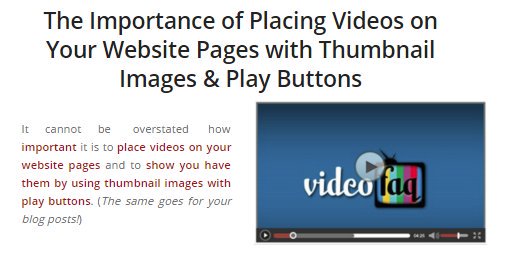CLICK ABOVE to Read the full article from The Video Content Marketing Guru!
It cannot be overstated how important it is to place videos on your website pages and to show you have them by using thumbnail images with play buttons. (The same goes for your blog posts!)
Perhaps you understand it is important to have helpful and educational videos for your company; in fact, it is very likely that is why you are reading this article right now. We have a wealth of information here for you that will help you and others in your company to more fully understand why that is true. However, many businesses and professionals will go through the steps of planning, creating, and even publishing these types of videos, but they fail to complete an extremely important and beneficial step in the distribution of their finished videos: They fail to embed their videos on their company’s website pages.
Visitors to your website appreciate having videos prepared that will explain answers to their questions or to explain the topic covered on a page of the website. For example, a personal injury firm may have a page on auto accidents, and they should have videos on that page explaining answers to common questions from clients and visitors regarding what they can do if they find themselves in such a situation, as well as an explanation of the processes that will likely be involved.
Most embedded video players, including YouTube, will display a “play” button over the video player or representative image (often called a thumbnail image) to indicate it is a playable video. If your video player does not show such a play button, then you need to prepare a thumbnail image, complete with a superimposed play button. Embed code for most players – including YouTube – is readily available, and can be pasted into the “html” or “text” of a website. Your webmaster should know what to do if you ask for it. If you have any questions, please don’t hesitate to ask us at NRV – We will be happy to explain it to you further.
Such an educational video could and should also be embedded in its own blog article, with the text below the embedded video supporting the content of the video itself. One common mistake when posting videos to blog articles is to fail to represent that there are videos in the blog’s preview. That is, many blogging platforms allow the webmaster to control how much of each article is shown before the visitor clicks on the article itself, and many times no thumbnail image is there to represent the video content. Or, if there is a thumbnail image, there is no play button. It is advisable to include either the embedded video in the blog article preview itself or to include a representative thumbnail with a play button. One may even go so far as to include “(Video)” in the article headline or include a “video” icon that makes it clear the visitor has the option to watch a video… The visitor will be more likely to click through to the article, to stay on the page longer, to appreciate the information and have a positive experience… And, this also positively affects your website’s SEO.
To recap:
- Your company needs informative and educational videos
- You need to embed those videos on your website’s topic pages
- You need to embed those videos in blog articles (published consistently as new content, along with your videos – Search engines love that for SEO!)
- You need to make it visibly clear that these videos are available, using video embed code and/or thumbnail images with superimposed “play” buttons.
Your firm’s ideal clients are searching online for answers you can provide. They are seeking topical video and written content that provides helpful information, demonstrates expertise, builds trust, and creates a loyal relationship. Improve your firm’s bottom line, recognition, and capacity for top results by optimizing your lead generation efforts with video content marketing. Fill out the form below for information on getting started!




